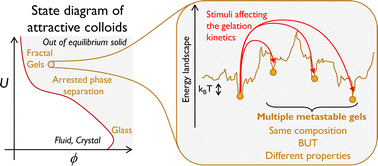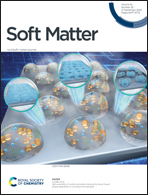Interpenetration of fractal clusters drives elasticity in colloidal gels formed upon flow cessation
Abstract
Colloidal gels are out-of-equilibrium soft solids composed of attractive Brownian particles that form a space-spanning network at low volume fractions. The elastic properties of these systems result from the network microstructure, which is very sensitive to shear history. Here, we take advantage of such sensitivity to tune the viscoelastic properties of a colloidal gel made of carbon black nanoparticles. Starting from a fluidized state at an applied shear rate ![[small gamma, Greek, dot above]](https://www.rsc.org/images/entities/i_char_e0a2.gif) 0, we use an abrupt flow cessation to trigger a liquid-to-solid transition. We observe that the resulting gel is all the more elastic when the shear rate
0, we use an abrupt flow cessation to trigger a liquid-to-solid transition. We observe that the resulting gel is all the more elastic when the shear rate ![[small gamma, Greek, dot above]](https://www.rsc.org/images/entities/i_char_e0a2.gif) 0 is low and that the viscoelastic spectra can be mapped on a master curve. Moreover, coupling rheometry to small angle X-ray scattering allows us to show that the gel microstructure is different from gels solely formed by thermal agitation where only two length scales are observed: the dimension of the colloidal and the dimension of the fractal aggregates. Competition between shear and thermal energy leads to gels with three characteristic length scales. Such gels structure in a percolated network of fractal clusters that interpenetrate each other. Experiments on gels prepared with various shear histories reveal that cluster interpenetration increases with decreasing values of the shear rate
0 is low and that the viscoelastic spectra can be mapped on a master curve. Moreover, coupling rheometry to small angle X-ray scattering allows us to show that the gel microstructure is different from gels solely formed by thermal agitation where only two length scales are observed: the dimension of the colloidal and the dimension of the fractal aggregates. Competition between shear and thermal energy leads to gels with three characteristic length scales. Such gels structure in a percolated network of fractal clusters that interpenetrate each other. Experiments on gels prepared with various shear histories reveal that cluster interpenetration increases with decreasing values of the shear rate ![[small gamma, Greek, dot above]](https://www.rsc.org/images/entities/i_char_e0a2.gif) 0 applied before flow cessation. These observations strongly suggest that cluster interpenetration drives the gel elasticity, which we confirm using a structural model. Our results, which are in stark contrast to previous literature, where gel elasticity was either linked to cluster connectivity or to bending modes, highlight a novel local parameter controlling the macroscopic viscoelastic properties of colloidal gels.
0 applied before flow cessation. These observations strongly suggest that cluster interpenetration drives the gel elasticity, which we confirm using a structural model. Our results, which are in stark contrast to previous literature, where gel elasticity was either linked to cluster connectivity or to bending modes, highlight a novel local parameter controlling the macroscopic viscoelastic properties of colloidal gels.



 Please wait while we load your content...
Please wait while we load your content...